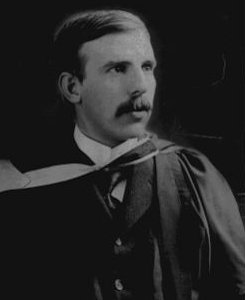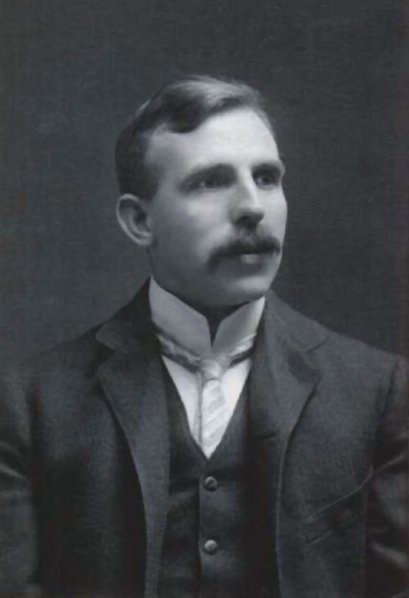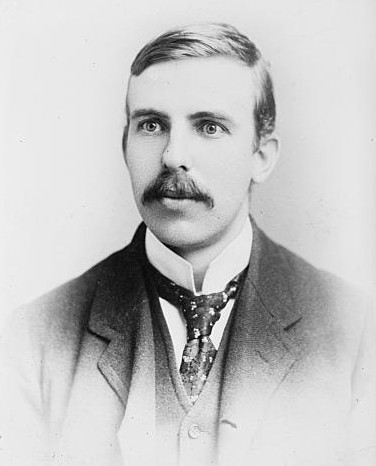<Back to Index>
- Chemist and Physicist Ernest Rutherford, 1871
PAGE SPONSOR



Ernest Rutherford, 1st Baron Rutherford of Nelson OM, FRS (30 August 1871 – 19 October 1937) was a New Zealand - born British chemist and physicist who became known as the father of nuclear physics. He is considered the greatest experimentalist since Michael Faraday (1791 – 1867).
In early work he discovered the concept of radioactive half - life, proved that radioactivity involved the transmutation of one chemical element to another, and also differentiated and named alpha and beta radiation, proving that the former was essentially helium ions. This work was done at McGill University in Canada. It is the basis for the Nobel Prize in Chemistry he was awarded in 1908 "for his investigations into the disintegration of the elements, and the chemistry of radioactive substances".
Rutherford performed his most famous work after he had moved to the Victoria University of Manchester in the U.K. in 1907 and was already a Nobel laureate. In 1911, although he could not prove that it was positive or negative; he theorized that atoms have their charge concentrated in a very small nucleus, and thereby pioneered the Rutherford model of the atom, through his discovery and interpretation of Rutherford scattering in his gold foil experiment. He is widely credited with first "splitting the atom" in 1917 in a nuclear reaction between nitrogen and alpha particles, in which he also discovered (and named) the proton. This led to the first experiment to split the nucleus in a fully controlled manner, performed by two students working under his direction, John Cockcroft and Ernest Walton, in 1932. After his death in 1937, he was honored by being interred with the greatest scientists of the United Kingdom, near Sir Isaac Newton's tomb in Westminster Abbey. The chemical element rutherfordium (element 104) was named after him in 1997.
Ernest Rutherford was the son of James Rutherford, a farmer, and his wife Martha Thompson, originally from Hornchurch, Essex, England. James had emigrated to New Zealand from Perth, Scotland, "to raise a little flax and a lot of children". Ernest was born at Spring Grove (now Brightwater), near Nelson, New Zealand. His first name was mistakenly spelled Earnest when his birth was registered.
He studied at Havelock School and then Nelson College and won a scholarship to study at Canterbury College, University of New Zealand, where he was president of the debating society, among other things. After gaining his BA, MA and BSc, and doing two years of research at the forefront of electrical technology, in 1895 Rutherford traveled to England for postgraduate study at the Cavendish Laboratory, University of Cambridge (1895 – 1898), and he briefly held the world record for the distance over which electromagnetic waves could be detected.
"Cambridge’s rules did not allow Rutherford to advance because of his youth" so in 1898 Rutherford was appointed to succeed Hugh Longbourne Callendar in the chair of Macdonald Professor of physics at McGill University in Montreal, Canada, where he did the work that gained him the Nobel Prize in Chemistry in 1908. In 1900 he gained a DSc from the University of New Zealand. Also in 1900 he married Mary Georgina Newton (1876 – 1945); they had one daughter, Eileen Mary (1901 – 1930), who married Ralph Fowler. In 1907 Rutherford moved to Britain to take the chair of physics at the University of Manchester.
He was knighted in 1914. In 1916 he was awarded the Hector Memorial Medal. In 1919 he returned to the Cavendish as Director. Under him, Nobel Prizes were awarded to James Chadwick for discovering the neutron (in 1932), John Cockcroft and Ernest Walton for an experiment which was to be known as splitting the atom using a particle accelerator, and Edward Appleton for demonstrating the existence of the ionosphere. He was admitted to the Order of Merit in 1925 and raised to the peerage as Baron Rutherford of Nelson, in 1931, a title that became extinct upon his unexpected death in 1937.
For some time beforehand, Rutherford had a small hernia, which he had neglected to have fixed, and it became strangulated, causing him to be violently ill. Despite an emergency operation in London, he died four days afterwards of what physicians termed "intestinal paralysis." He was given the high honor of burial in Westminster Abbey, near Isaac Newton and other illustrious British scientists.
During the investigation of radioactivity he coined the terms alpha ray and beta ray in 1899 to describe the two distinct types of radiation emitted by thorium and uranium. These rays were differentiated on the basis of penetrating power. From 1900 to 1903 he was joined at McGill by the young Frederick Soddy (Nobel Prize in Chemistry, 1921) and they collaborated on research into the transmutation of elements. Rutherford and Soddy demonstrated that radioactivity was often the spontaneous disintegration of atoms into other types of atoms (one element spontaneously being changed to another). This would suggest that radioactivity was a nuclear phenomenon, but the nucleus of the atom was not then known (Rutherford himself would later deduce it in 1911).
While studying radioactivity, he noticed that a sample of radioactive material invariably took the same amount of time for half the sample to decay — its "half - life" — and created a practical application using this constant rate of decay as a clock, which could then be used to help determine the age of the Earth, which turned out to be much older than most of the scientists at the time believed.
In 1903, Rutherford considered a type of radiation discovered (but not named) by French chemist Paul Villard in 1900, as an emission from radium, and realized that this observation must represent something different from his own alpha rays and beta rays, due to its very much greater penetrating power. Rutherford therefore gave this third type of radiation the name of gamma ray, which was retained by the scientific community. All three of Rutherford's terms are in standard use today (other types of radioactive decay have since been discovered, but Rutherford's three types are among the most common).
In Manchester, he continued to work with alpha radiation. In conjunction with Hans Geiger, he developed zinc sulfide scintillation screens and ionization chambers to count alphas. By dividing the total charge they produced by the number counted, Rutherford decided that the charge on the alpha was two. In late 1907, Ernest Rutherford and Thomas Royds allowed alphas to penetrate a very thin window into an evacuated tube. As they sparked the tube into discharge, the spectrum obtained from it changed, as the alphas accumulated in the tube. Eventually, the clear spectrum of helium gas appeared, proving that alphas were at least ionized helium atoms, and probably helium nuclei.
Rutherford remains the only science Nobel Prize winner to have performed his most famous work after receiving the prize. Along with Hans Geiger and Ernest Marsden in 1909, he carried out the Geiger – Marsden experiment, which demonstrated the nuclear nature of atoms. Rutherford was inspired to ask Geiger and Marsden in this experiment to look for alpha particles with very high deflection angles, of a type not expected from any theory of matter at that time. Such deflections, though rare, were found, and proved to be a smooth but high - order function of the deflection angle. It was Rutherford's interpretation of this data that led him to formulate the Rutherford model of the atom in 1911 – that a very small charged nucleus, containing much of the atom's mass, was orbited by low mass electrons.
Before leaving Manchester in 1919 to take over the Cavendish laboratory in Cambridge, Rutherford became, in 1917, the first person to deliberately transmute one element into another. In this experiment, he had discovered peculiar radiations when alphas were projected into air, and narrowed the effect down to the nitrogen, not the oxygen in the air. Using pure nitrogen, Rutherford used alpha radiation to convert nitrogen into oxygen through the nuclear reaction 14N + α → 17O + proton. The proton was not then known. In the products of this reaction Rutherford simply identified hydrogen nuclei, by their similarity to the particle radiation from earlier experiments in which he had bombarded hydrogen gas with alpha particles to knock hydrogen nuclei out of hydrogen atoms. This result showed Rutherford that hydrogen nuclei were a part of nitrogen nuclei (and by inference, probably other nuclei as well). Such a construction had been suspected for many years on the basis of atomic weights which were whole numbers of that of hydrogen (Prout's hypothesis). Hydrogen was known to be the lightest element, and its nuclei presumably the lightest nuclei. Now, because of all these considerations, Rutherford decided that a hydrogen nucleus was possibly a fundamental building block of all nuclei, and also possibly a new fundamental particle as well, since nothing was known from the nucleus that was lighter. Thus, Rutherford postulated hydrogen nuclei to be a new particle in 1920, which he dubbed the proton.
In 1921, while working with Niels Bohr (who postulated that electrons moved in specific orbits), Rutherford theorized about the existence of neutrons, which could somehow compensate for the repelling effect of the positive charges of protons by causing an attractive nuclear force and thus keep the nuclei from flying apart from the repulsion between protons. The only alternative to neutrons was the existence of "nuclear electrons" which would counteract some of the proton charges in the nucleus, since by then it was known that nuclei had about twice the mass that could be accounted for if they were simply assembled from hydrogen nuclei (protons). But how these nuclear electrons could be trapped in the nucleus, was a mystery.
Rutherford's theory of neutrons was proved in 1932 by his associate James Chadwick, who recognized neutrons immediately when they were produced by other scientists and later himself, in bombarding beryllium with alpha particles. In 1935, Chadwick was awarded the Nobel Prize in Physics for this discovery.
Rutherford's research, and work done under him as laboratory director, established the nuclear structure of the atom and the essential nature of radioactive decay as a nuclear process. Rutherford's team, using natural alpha particles, demonstrated induced nuclear transmutation and transmutation, and later, using protons from an accelerator, demonstrated artificially induced nuclear reactions and transmutation. He is known as the father of nuclear physics. Rutherford died too early to see Leó Szilárd's idea of controlled nuclear chain reactions come into being. However, a speech of Rutherford's about his artificially induced transmutation in lithium, printed in the 12 September 1933 London paper The Times, was reported by Szilárd to have been his inspiration for thinking of the possibility of a controlled energy - producing nuclear chain reaction. Szilard had this idea while walking in London, on the same day.
Rutherford's speech touched on the 1932 work of his students John Cockcroft and Ernest Walton in "splitting" lithium into alpha particles by bombardment with protons from a particle accelerator they had constructed. Rutherford realized that the energy released from the split lithium atoms was enormous, but he also realized that the energy needed for the accelerator, and its essential inefficiency in splitting atoms in this fashion, made the project an impossibility as a practical source of energy (accelerator - induced fission of light elements remains too inefficient to be used in this way, even today). Rutherford's speech in part, read:
- We might in these processes obtain very much more energy than the proton supplied, but on the average we could not expect to obtain energy in this way. It was a very poor and inefficient way of producing energy, and anyone who looked for a source of power in the transformation of the atoms was talking moonshine. But the subject was scientifically interesting because it gave insight into the atoms.